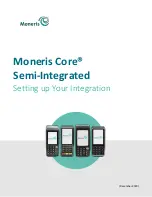
Chapter 24
Sequencer Instructions
24–3
Entering Parameters
•
File (SQO, SQC) – This is the address of the sequencer file. You must
use the file indicator # for this address.
Sequencer file data is used as follows:
Instruction
SQO
SQC
Sequencer File Stores
Data for controlling outputs
Reference data for monitoring inputs
•
Mask (SQO, SQC) – This is a hex code or the address of the mask word
or file through which the instruction moves data. Set mask bits to pass
data, reset mask bits to mask data. Use a mask word or file if you want to
change the mask according to application requirements.
If the mask is a file, its length will be equal to the length of the sequencer
file. The two files track automatically.
•
Source (SQC) – This is the address of the input word or file from which
the instruction obtains data for comparison to its sequencer file. For input
data file addresses, the HHT requires that you enter the slot and word
number. For example, I:3.0.
•
Destination (SQO) – This is the address of the output word or file to
which the instruction moves data from its sequencer file. For output data
file addresses, the HHT requires that you enter the slot and word number.
For example, O:4.0.
Important: You can address the mask, source, or destination of a sequencer
instruction as a word or file. If you address it as a file (using
file indicator #), the instruction automatically tracks through the
source, mask, or destination file as the instruction tracks
step-by-step through its sequencer file.
•
Control (SQO, SQC) – This is the instruction’s address and control
element (R6 data file) that stores the status byte of the instruction, the
length of the sequencer file, and the instantaneous position in the file.
EN DN ER FD
15 13 11 08 00
Length of sequencer file
Position
Note: You cannot use the control address for any other instruction.
















































